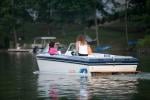Awesome, sounds like your cam is broken in just fine. If you haven't changed the oil yet after cam break in then do that before taking it out on the water. Your break in oil and filter are full of metal from the cam and lifters wearing together along with assembly lube and any other junk you don't want in the oil. You want clean fresh oil for actually running it under load.
Rings can take a little while to seat. Two schools of thought on this. One is take it easy and vary RPM so they gently wear in to the bores. The other is run it hard, several hard pulls working up to WOT and back off letting engine braking keep revs up a bit while slowing down (that bit not as practical in a boat, but some props do have a lot of bite), at first stopping at lower RPM then working up to higher RPM. The theory is more aggressive acceleration and deceleration yields higher cylinder pressures which helps the rings wear together to the bores more quickly.
I used to be of the former crowd, generally going pretty easy but varying RPM and load as much as possible. Now I'm slightly more favoring the latter method as I believe it seats the rings more quickly. I've driven engines both ways during the break in period but don't think it makes a big difference. Parts wear together fairly quickly either way and I've never had a problem with ring seal using either method. Pick your poison, I won't advise you one way or the other aside from avoid extended idling for the first 20 hours or so. Idling, particularly before the rings are fully worn in and seated, can build up carbon and blow by between the rings and lands. Change the oil immediately after cam break in and again after 20-25 hours. After that go to your normal oil change interval.


 Reply With Quote
Reply With Quote






